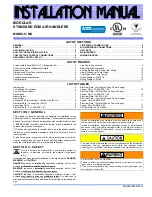
54
SSCBL-RPBL-IOM (10-22) 149159-C
CONTROLS—CONTINUED
Optional Electronic Modulation—Continued
Electronic Modulation Between 25% and 100% Firing Rate (Options AG39, AG40, AG41, and AG42)—Cont.
•
The gas supply (refer to pressure requirements in
) connects to the single-stage gas valve . To compensate
for additional pressure loss through the modulating valve, the single-stage gas valve has a custom outlet pressure
setting higher than when it is used on a standard gas manifold . The pilot tubing connects to the pilot port on the
single-stage gas valve .
Table 28. Options AG39, AG40, AG41, and AG42 Pressure Requirements
Unit
Size
Maximum Turndown
(%)
Input Range
(MBH)
Factory-Set Inlet Pressure
to Modulating Valve
(IN WC)
Required
Gas Supply Pressure
(IN WC)
500
28
69–250
4 .0
5 .0
600
23
69–300
4 .0
5 .0
400, 800, 1200
25
100–400
4 .4
6 .0
•
When the valve receives a call for heat from the amplifier and pilot is established, gas flow from the single-stage
valve goes to both the modulating valve and the regulated lighter tube system . When the signal from the amplifier
to the modulating valve requires less-than-high fire operation, the modulating valve functions to lessen the gas
flow to the burner to reduce the input rate to that which is necessary to maintain the desired temperature . When
the input rate is reduced enough to decrease the gas pressure to 1 .1 IN WC, the primary gas pressure switch in
the manifold activates the gear motor that controls the bypass damper in the venter/combustion air system . The
bypass damper opens to divert some of the incoming air directly into the flue duct to reduce air flow through the
burner . Safety switches monitor the position of the bypass damper . When the gas pressure rises to >1 .1 IN WC,
the bypass damper closes .
• Sensor location for options AG39 and AG41:
For the convenience of the installer, the duct temperature sensor
is factory-installed in the cabinet leg (see
) . Although the sensor has a mixing tube, at this distance from
the discharge it does not receive a true mix, so the temperature read by the sensor will be slightly higher than the
actual air entering the ductwork . The system will provide comfort level heat if the selector is set slightly lower to
compensate for this reading . The offset temperature will vary with the application . If a direct correlation of these
two temperatures is required, move the duct sensor to a location in the ductwork about 10–12 feet (3–3 .7 meters)
from the furnace discharge . Refer to the
Discharge Air Temperature Sensor Installation
section for instructions
on locating the sensor in the ductwork .
•
This uniquely-designed modulation system requires combustion air pressure settings different from the standard
system . Refer to
for the approximate combustion air proving switch settings at sea-level operation and
Computer-Controlled Electronic Modulation Between 25% and 100% Firing Rate (Options AG40 and AG42)
•
The furnace is equipped with a Maxitrol signal conditioner (see
) that receives an input signal of either
4–20mA or 0–10V from a customer-supplied control device such as a computer .
•
With the dip switches on the conditioner positioned to ON, the conditioner accepts a 4–20mA signal . With the dip
switches on the conditioner positioned to OFF, the conditioner accepts a 0–10V signal . The conditioner converts
the signal to the 0–20V DC current required to control the modulating valve . The furnace functions and is equipped
in the same way as options AG39 and AG41 except that with computer control, the temperatures are selected
through the software and there is no temperature selector or duct sensor .
•
for pressure requirements and to
•
This uniquely-designed modulation system requires combustion air pressure settings different from the standard
system . Refer to
for the approximate combustion air proving switch settings at sea-level operation .
















































